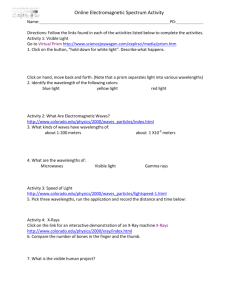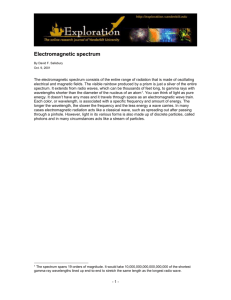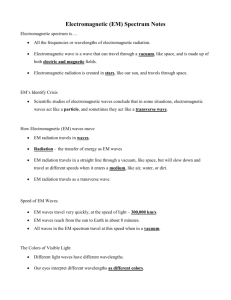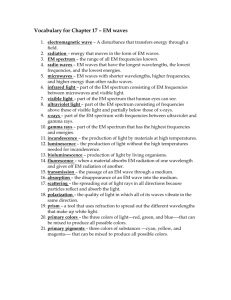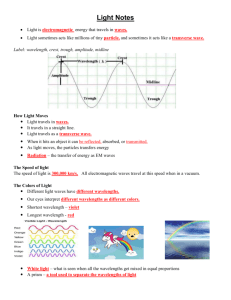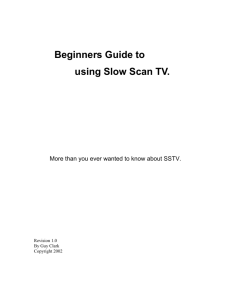SSTV_template_colors
advertisement
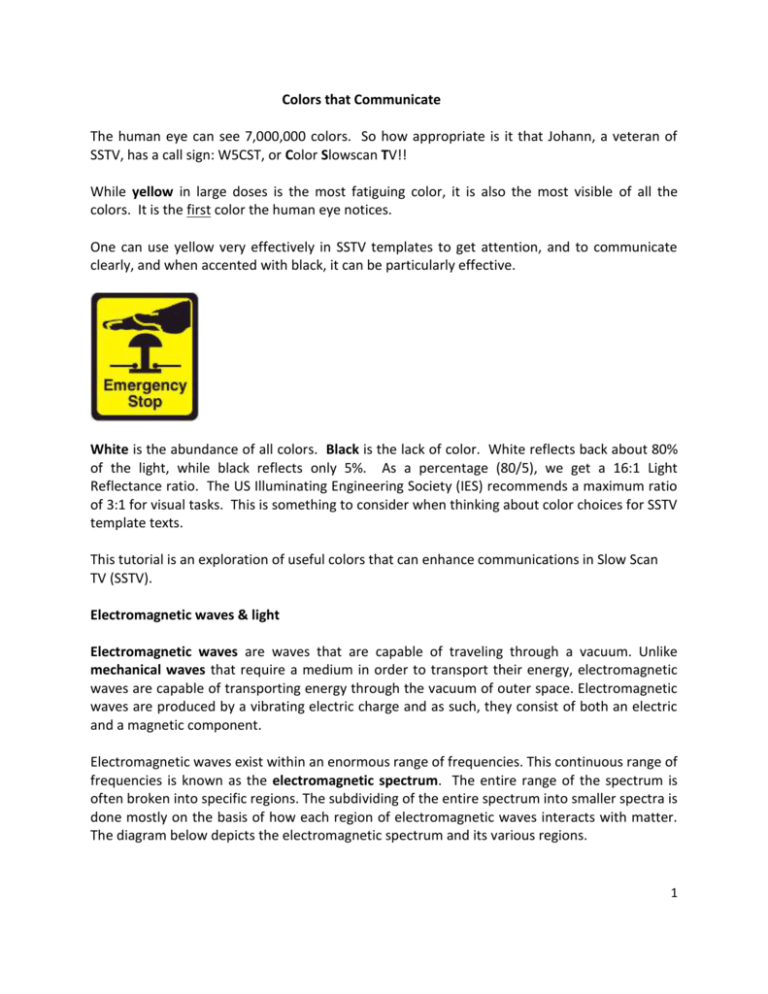
Colors that Communicate The human eye can see 7,000,000 colors. So how appropriate is it that Johann, a veteran of SSTV, has a call sign: W5CST, or Color Slowscan TV!! While yellow in large doses is the most fatiguing color, it is also the most visible of all the colors. It is the first color the human eye notices. One can use yellow very effectively in SSTV templates to get attention, and to communicate clearly, and when accented with black, it can be particularly effective. White is the abundance of all colors. Black is the lack of color. White reflects back about 80% of the light, while black reflects only 5%. As a percentage (80/5), we get a 16:1 Light Reflectance ratio. The US Illuminating Engineering Society (IES) recommends a maximum ratio of 3:1 for visual tasks. This is something to consider when thinking about color choices for SSTV template texts. This tutorial is an exploration of useful colors that can enhance communications in Slow Scan TV (SSTV). Electromagnetic waves & light Electromagnetic waves are waves that are capable of traveling through a vacuum. Unlike mechanical waves that require a medium in order to transport their energy, electromagnetic waves are capable of transporting energy through the vacuum of outer space. Electromagnetic waves are produced by a vibrating electric charge and as such, they consist of both an electric and a magnetic component. Electromagnetic waves exist within an enormous range of frequencies. This continuous range of frequencies is known as the electromagnetic spectrum. The entire range of the spectrum is often broken into specific regions. The subdividing of the entire spectrum into smaller spectra is done mostly on the basis of how each region of electromagnetic waves interacts with matter. The diagram below depicts the electromagnetic spectrum and its various regions. 1 Though electromagnetic waves exist in a vast range of wavelengths, our eyes are sensitive to only a very narrow band. Since this narrow band of wavelengths is the means by which humans see, we refer to it as the visible light spectrum. Normally when we use the term "light," we are referring to a type of electromagnetic wave that stimulates the retina of our eyes. This visible light region consists of a spectrum of wavelengths that range from approximately 700 nanometers (red color) (abbreviated nm) to approximately 400 nm (violet color). This narrow band of visible light is affectionately known as ROYGBIV: Red, Orange, Yellow, Green, Blue, Indigo, and Violet. Each individual wavelength within the spectrum of visible light wavelengths is representative of a particular color. When all the wavelengths of the visible light spectrum strike your eye at the same time, white is perceived. The sensation of white is not the result of a single color of light. Thus, visible light the mix of ROYGBIV - is sometimes referred to as white light. Technically speaking, white is not a color at all - at least not in the sense that there is a light wave with a wavelength that is characteristic of white. Rather, white is the combination of all the colors of the visible light spectrum. If all the wavelengths of the visible light spectrum give the appearance of white, then none of the wavelengths would lead to the appearance of black. Once more, black is not actually a color. Technically speaking, black is merely the absence of the wavelengths of the visible light spectrum. So when you are in a room with no lights and everything around you appears black, it means that there are no wavelengths of visible light striking your eye as you sight at the surroundings. 2 Designing SSTV templates to be read in weak signal environments If you want high visibility, high contrast is the key. Just considered these four examples of high & low contrast, and the ease or difficulty YOU have with reading in perfect conditions. The chart below ranks the 14 most visible color combinations, with 1 being the most legible. Keep this in mind as you select the text colors for your template. Often you may have a variety of templates, but with different text colors to contrast with light- and dark-color background pictures you intend to transmit. Design tips Let’s considers some tips now which you can immediately apply to create effective SSTV templates that will communicate in color. Keep It Simple: The first step to creating effective messages is to keep the wording short and succinct. Keep It Big: Large text will allow hams to see your message from a greater distance. If your text is too small, it will be too hard to read. 3 Keep It Clean: Avoid using thin fonts, as well as most script fonts. The strokes of each character are simply too thin to maintain legibility over long distances. Use thick, heavy fonts to maximize readability. Keep It Colorful: High color contrast is a key ingredient. Just like using large text, the right color combination can make your message readable from a much longer distance. Examples Let’s conclude by looking at some examples of SSTV transmissions that I’ve received at WB9KMW and see what works and what doesn’t work very well in weak signal situations. White is always nice, and here is my friend, Johann W5CST from Texas. Next to him is a signal I receive regularly from Argentina, LU1FVN. He makes nice use of yellow & black, BUT the most important part of his template is his call sign, and here the font size is too small for consistent weak signal readability from my QTH which is 5,600 miles away. 4 However, white-on-white is not a good choice. Here is a ham that used a nice, large font but chose to use white on a white background. That definitely does not work. He was copied fine by a ham in the Netherlands, PD2PW, but I could not make out his call! I would have with a better choice of text color . Here is DJ1IJ located 4,200 miles away from me in Germany. You see his red lettering coming through nicely, but in the next transmission that light blue does not communicate well! 5 UU4JM, who is 5,300 miles away in the Ukraine, starts out nicely with his choice of red, yellow & blue with white outlining of the letters. Then he switches to the multi-color, designer mode. Today I can copy his signal, but the template in this second transmission is not as distinct. SP9IIA in Poland (4,600 miles away) gets his most of his message across with the yellow font, although for DX operations, the font sizes in some parts of this template are too small to copy. And S57ILF in Slovenia (4,600 miles away) gets a good part of his message through, again with strategic use of yellow and a good font size. 6 Here we have a couple of SSTV images that I can’t read. Color & font size would have helped! Ted W9EXP in Florida does a nice job with his template, and VE6KEL in Alberta, Canada makes a good enough case for me to know I can reply to his CQ. 7 I received the clear image on the left with an SDR radio tuned to 14.230 MHz in the Netherlands with the SSTV signal translated by me in my ham shack in Wisconsin. That same image, also translated by another MMSSTV program running in my ham shack and using the signal received with my Kenwood TS-590S here in Wisconsin, is not as good. This is a fine illustration of which call sign letters get through and which do not at the very moment such critical information is being transmitted, by CT1EDP from Portugal. Be careful about being too loquacious when bragging about your great ham shack & antenna farm. This time it worked for F5PON in France, but with a bit weaker signal, Mike would be out of luck with me. 8 So if I had a choice, I’d opt for the clear, distinct template from SP9IIA (OK, let’s straighten that image out!) rather than that weak green from KD8PNJ. At least I can read his white call sign with black border in the upper right corner. Notice how this smaller font size is more distinct that the larger green font across the UFO space ship. 9


